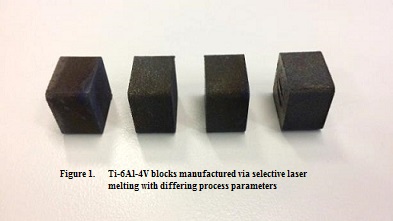
Introduction: Titanium (Ti) and its alloys are biomedical materials used extensively in orthopaedic applications such as hip and knee replacements. Ti displays low cytotoxicity and high mechanical strength[1,][2]. However, these properties may prevent full functionality, particularly for patients with complex orthopaedic issues. The surfaces of Ti-based implants do not typically induce strong mechanical interlocking[3], and the modulus mismatch between the implant and host bone can lead to stress shielding and bone resorption. These issues often necessitate painful and costly revision surgeries. New generation fabrication techniques with modified alloys are thus being investigated to improve the osseoconductive properties of orthopaedic implants. Selective Laser Melting (SLM) has the capability to rapidly produce customised implants out of conventionally difficult to machine materials[4]. Current research is focused on fully classifying the effects of various processing parameters on SLM-produced part properties as well as the effects of varying alloy compositions on bio-performance. Various post-process techniques to improve biocompatibility are also under investigation. Hydroxyapatite is a bone-like mineral which has been shown to improve host-implant interactions when coated onto implants, however, it is difficult to work with due to insolubility and brittleness.
Materials and Methods: This study presents the results of iterative analyses of the effects of SLM fabrication parameters on part properties, as well as the specific behaviour of Ti-6Al-4V and Ti-Nb-Zr based alloys under these conditions. Electro-impedance spectroscopy and cyclic voltammetry were performed to determine the effects of build parameters on subsequent electrochemical behaviour. Cytocompatibility testing was conducted with osteoblasts to ascertain the extent of osseoinductive properties of SLM produced implants. The microstructural and surface characteristics were observed using scanning electron microscopy and energy-dispersive X-ray spectroscopy. This study also presents the optimisation of a two-step protocol for the deposition of modified hydroxyapatite on SLM part surfaces.
Results and Discussion: This study presents a set of preliminary data on the effects of varying SLM build parameters on Ti-6Al-4V and Ti-Nb-Zr based alloys, as well as the osseoinductive potential of SLM produced implants. This data is integral in providing confidence in the design and printing of custom implants.
Conclusion: The combination of highly osseoinductive alloy compositions, an awareness of the effects of varying fabrication and process parameter, and the optimisation of post-processing value-adding techniques will improve the performance and service life of hip implants.
References:
[1] Butscher a., Bohner M, Hofmann S, Gauckler L, Müller R. Structural and material approaches to bone tissue engineering in powder-based three-dimensional printing. Acta Biomater 2011;7:907–20. doi:10.1016/j.actbio.2010.09.039.
[2] Murr LE, Martinez E, Amato KN, Gaytan SM, Hernandez J, Ramirez D a., et al. Fabrication of Metal and Alloy Components by Additive Manufacturing: Examples of 3D Materials Science. J Mater Res Technol 2012;1:42–54. doi:10.1016/S2238-7854(12)70009-1.
[3] Vandenbroucke B, Kruth J-P. Selective laser melting of biocompatible metals for rapid manufacturing of medical parts. Rapid Prototyp J 2007;13:196–203. doi:10.1108/13552540710776142.
[4] Marcu T, Menapace C, Girardini L, Leordean D, Popa C. Selective laser melting of Ti6Al7Nb with hydroxyapatite addition. Rapid Prototyp J 2014;20:301–10. doi:10.1108/RPJ-09-2012-0083.